Retrofitting A Pedestrian Access Route To The Former Schnucks In Des Peres, MO
Based on comments on Monday’s post (Walking To The “Flagship” Dierbergs & Schnucks Locations In Des Peres, MO) many of you think the auto-centric suburbs will never be walkable. Well, you’re wrong. They’ll likely never be ideal urban settings but they can be retrofitted to enable people to function without having to drive. This is important because we need to walk more:
There is a growing recognition that Americans must increase physical activity, including walking or bicycling, if we are to nudge the needle on ballooning health care costs, reducing obesity and overweight, cardiovascular and other chronic illnesses linked to a lack of exercise. Over the last decade, a growing number of communities have gotten the message, and begun to retrofit their more dangerous roadways to be safer for people on foot, on bicycles and in cars.
Still, most Americans continue to live in places where walking is risky business for their health and safety, where roads are designed solely to move speeding traffic and where pedestrians are viewed as an obstacle.
This has left us with a dilemma: Public health officials encourage Americans of all ages to walk and bike more to stem the costly and deadly obesity epidemic – yet many of our streets are simply not safe. Americans get to pick their poison: less exercise and poor health, or walking on roads where more than 47,000 people have died in the last ten years. (Dangerous by Design 2011)
Des Peres and other St. Louis suburbs have had sidewalks along major roads for years, yet few pedestrians. The lack of connection from the public sidewalk to the businesses set back behind parking lots has been a major hurdle. When these older commercial buildings are retrofitted or replaced we have the opportunity to make incremental improvements to improve the walkability. For example, the location of the old Schnucks grocery in Des Peres.
Schnucks was there for over 40 years but, like the new location, it didn’t have any pedestrian route to the store. Now the building has a new facade and two new retailers and a pedestrian access route.
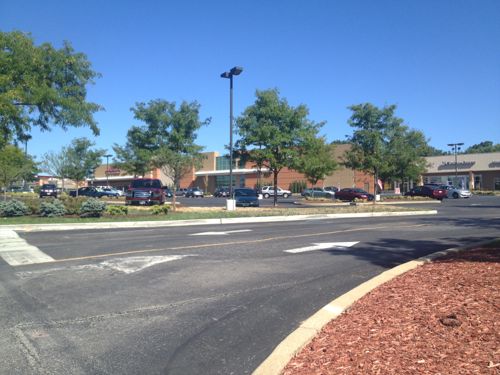
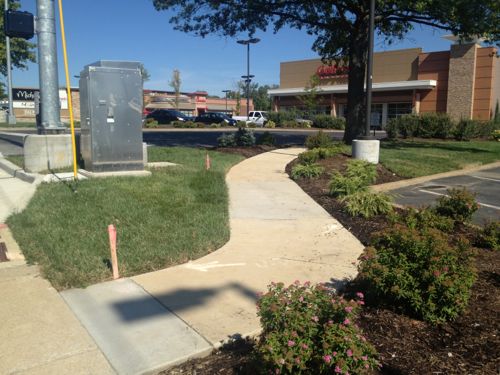
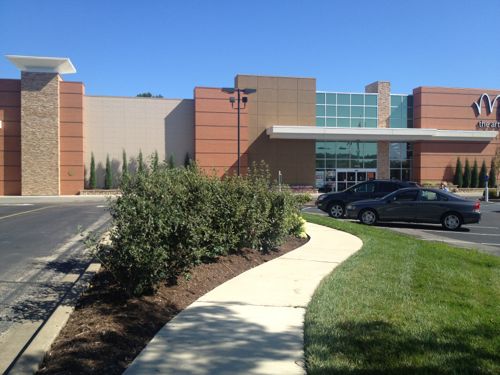
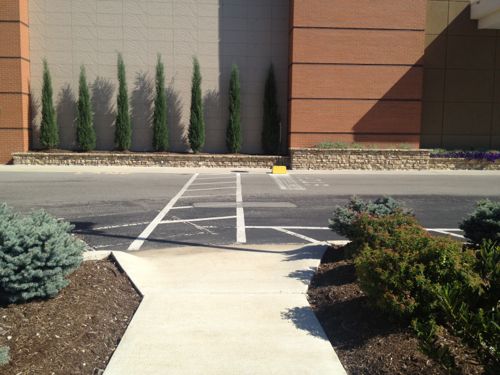
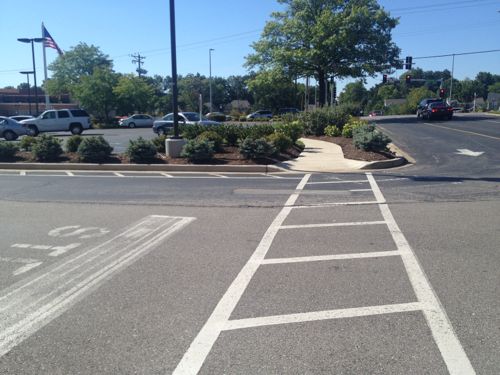
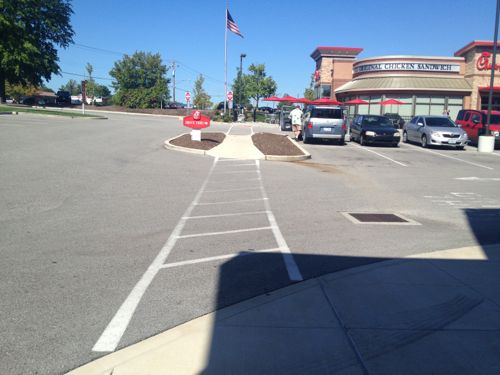
This is not great urbanism, nor is it my idea of walkable. But, I was able to easily get to the businesses without feeling like I might get hit by a careless motorist. It’s incrementally more walkable than it’s been for the over four decades. Walkability doesn’t happen overnight. Des Peres will not become a great walkable community by 2014, but it might by 2032.
I’ve posted the following video before but it’s worth watching over and over. Ellen Dunham-Jones shows us ways to retrofit the suburban sprawl few like but that many call home. Well worth 20 minutes of your time.
httpv://www.youtube.com/watch?v=yPkalOtT6i4
Continuing with a laissez-faire development strategy will, however, guarantee Des Peres and similar suburbs won’t be much different in 20 years. In 20 years the marketplace will pass up suburbs that require an automobile to function. Within the next two decades those communities where various modes of mobility are embraced will be the desirable “location, location, location” places. This includes walking, biking transit and yes, driving.
— Steve Patterson
Yes, contiguous sidewalks, ideally separated from vehicular traffic, makes walking more attractive in suburban areas. But people don’t walk along Manchester more because of low densities than because of any lack of pedestrian infrastructure – it’s simply too damn far between individual stores and services, not much different than the large lots for the the adjacent subdivisions. Yes, people “could” take the bus, but most people choose to drive. Until you eliminate the free parking at every store, not much is going to change . . .
I guess the other pedestrians I saw were just a mirage? Perhaps we should go out there and tell them they shouldn’t be walking because a motorist says so? Many more people than you realize walk from place to place — some just for the exercise and others have no choice. Many workers arrive via MetroBus — they’re pedestrians once they exit the bus.
Never said that people shouldn’t be walking, nor did I say that we shouldn’t be investing in pedestrian infrastructure. My point is that we’re “putting lipstick on a pig” – low density, suburban sprawl means that it’s a long hike between pretty much anywhere, so the vast majority of people will choose to drive simply because it’s quicker, more comfortable and not subject to the vagaries of transit bus schedules. Metro’s 57 bus along Manchester runs every 40 minutes during the day, making it very inconvenient if you have any sort of schedule to keep. And it’s the classic chicken-or-egg conundrum – the low frequency is adequate for the current ridership, but would the ridership double in the frequency were halved? Waiting 20 (or 13 or 10) minutes for a missed bus is much more doable for most people than is/would be waiting 30-40 minutes for the next bus to show up (with the current schedule).
The number of pedestrians in suburbia will always pale compared to the number of motorists, that doesn’t mean their mobility and safety shouldn’t be a public concern. Yes the bus is only every 40 minutes, but it was full. How else would workers without cars get to their jobs? You may not want to walk in Des Peres but if you live 3-3 blocks from the grocery store and you need to buy groceries you’ll walk there if you don’t have a car. Or if it’s a nice day out and your doctor told you to get more exercise. Improve roads and people drive more, improve/create sidewalks and people walk more.
We have similar goals but a different perspective on what makes an area “walkable”. My perspective is that focusing on sidewalks, absent any efforts to increase density, is a low priority. The bigger priority should be convincing people who now drive to do less driving / “give up” their cars for some / more trips. Bus schedules that require both a lot of planning and 2-3+ times as long to get between point A and point B, especially in the suburbs / areas with ample “free” parking are a much bigger hurdle to most people than having a dedicated sidewalk between Manchester and the front door. Make parking “expensive”, make distances between multiple destinations shorter – it doesn’t matter if it’s an urban downtown or a suburban lifestyle center. Run buses (or streetcars or pedicabs) so frequently that you don’t need a schedule, not expect people to be OK with waiting nearly an hour. These all need higher densities to work their best. Conversely, most people who choose to live in the suburbs do so because driving is easy, not because walking and/or transit is difficult – it’s all about personal choices.
I get it. Your needs and choices are different than mine. You’re a part of two minorities that place a much higher value on complete and comprehensive transit and pedestrian systems than those the rest of us who do drive every day. I have no objection to requiring logical, complete pedestrian access to every new project, even in the ‘burbs. I have no problem with local governments requiring an ADA compliant path of travel, even on existing facilities, by a date certain. But, in the end, it would be better to convince Shnuck’s to replicate what they have available in their Des Peres store at every other store they operate in the city than it would be to try and remake Des Peres into a pedestrian mecca ABSENT ANY EFFORT TO INCREASE DENSITY! Why should any of us have to trek past several of their other stores to get the premium services and products that are apparently only available here? And, at what point does trying to operate public transit in low-density areas simply become financially irresponsible? In some ways, “the grass is always greener”. Personally, I’d rather support businesses, developments and communities doing the right things than to attempt to reeducate companies or government leaders who either “don’t get it”, or worse, are passively-aggressively opposed to any type of government regulation of or intervention in the private sector . . . .
“According to the National Household Travel Survey (NHTS) completed in 2009, there are an estimated 42 billion walking trips nationwide every year. To put this statistic in perspective, Americans take a total of about 388 billion annual trips. Walking trips, thus, make up roughly 10.9 percent of all trips.” http://www.walkinginfo.org/facts/statistics.cfm
Downtown, probably 50%+ of all trips use walking. Out in the ‘burbs, not so much – for every pedestrian you see along Manchester you can count hundreds, and probably thousands, of vehicles passing by . . . .
The Dutch are great at ensuring pedestrian (and bike) access. Here’s an example I’m familiar with and which works well: the ikea at Sontplein 3 9723 BZ Groningen, Netherlands. If you google-map that address and look at the satellite photo close up you can see that this is a big-box store in a suburb-type neighborhood. There are separate access routes for cars, bikes, and pedestrians from the main street (Sontweg), and a bus stop in front. The entrance for pedestrians leads from the sidewalk along Sontweg straight to the main entrance of the store, with crosswalks at all driveway crossings. The sidewalk is situated between the parked cars (i.e. a gap between the fronts of the cars, protected by curbs), and is wide with benches and landscaping. In the aerial photo the pedestrian path is near the handicapped parking and the bike entrance are the burgandy-colored paths; they lead to the bike parking under the building.
I looked at the map, it is not surprising the Netherlands would do a better job providing equal access for all modes of transit including pedestrians. I still don’t like the overall effect of the box stores. There are are a number of European countries that limit the intrusion of box stores with varying degrees of success. (In Harvard Design Review, Guide to Shopping).
All of the parking is a problem, Groningen seems to do a fairly good job of keeping the streets themselves walkable until you get to Ikea with the broad space of parking in front. That is more akin the the St. Louis method of urban design.
There is a good discussion about parking in Vallingby and Farsta by David Pass (Suburbs built in the sixties outside both North and South of Stockholm). Vallingby integrated parking with the landscape while Farsta had a broad parking lot surrounding the center. The Stockholm planners decided that the Farsta Centrum didn’t work as well as Vallingby due to the conception and execution of the parking.
Actually you can see the difference on Google Maps, follow the rail line to the center in each case.
I don’t like big box stores, either. The Groningen ikea comes to mind because it’s the closest thing we experienced to American-style development when we lived there, but even that is easily accessible by foot. Every time I drive to the Brentwood Target strip mall or walk to the Richmond Heights Schnucks I think of the contrast (and St Louis doesn’t win).
Tulsa is having the conversation about right-sizing their transit service area versus maintaining existing poor frequencies with a larger coverage area: http://www.tulsaworld.com/news/article.aspx?subjectid=11&articleid=20120913_11_0_hrimgs196861
I’m glad that they made the buildings accessible to pedestrians, that’s a step in the right direction. However, making this strip of Manchester “walkable” would mean this: good urbanism. The ideal “walkable” Manchester would look like this: there would be buildings built up to the curb(!). You could either level the existing buildings and start over or do infill of buildings in the *ample* parking lots. These would be mixed-use buildings 2-5 storeys tall (or more) with retail/restaurants on the bottom floor and apartments/offices above them. Every couple of blocks there would be a parking garage with stores on the ground floor to take the place of the existing surface parking without breaking the flow. There would be, of course, continuous sidewalks connecting to residential neighborhoods just off of Manchester. There would be on-street parking (like in downtown Maplewood). There would be trees lining the streets (both the on street parking and the trees create a wall between the pedestrians and the traffic).
If developers start doing this, then I’ll agree that they’re making Manchester walkable.
They can start with the Shop-n-Save shopping center in downtown Maplewood and work their way west!
Scott